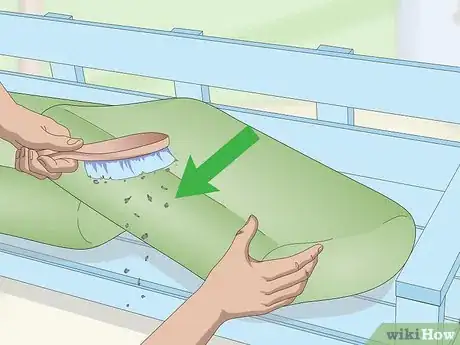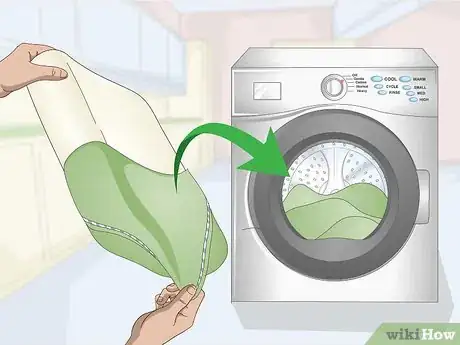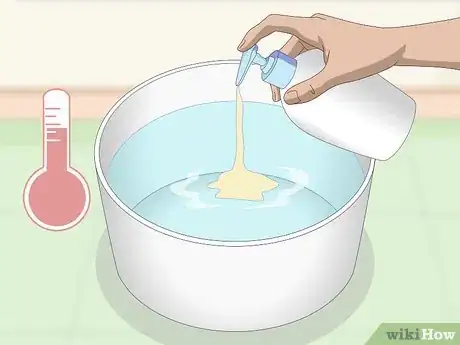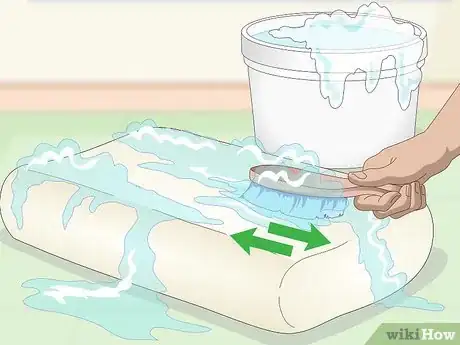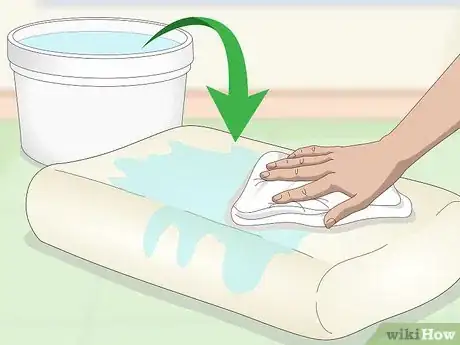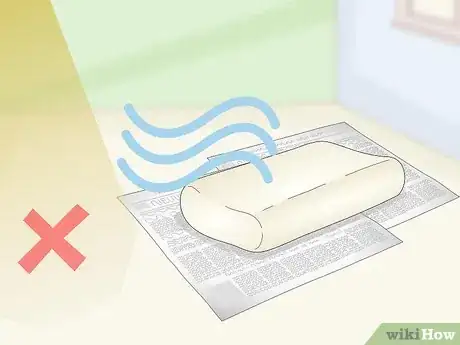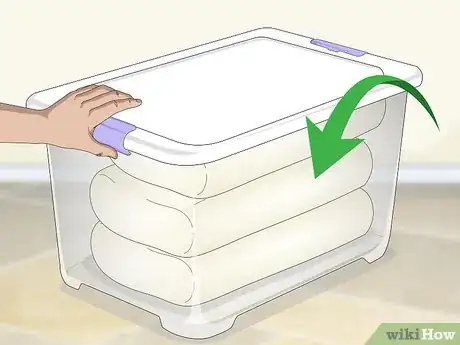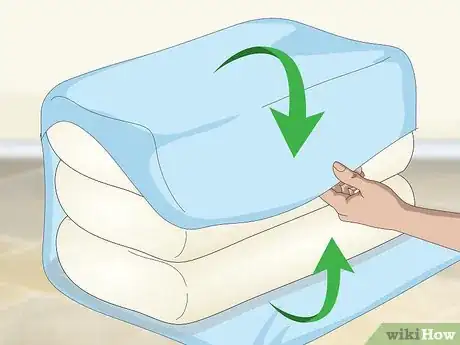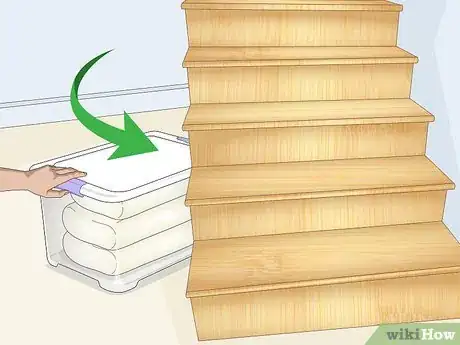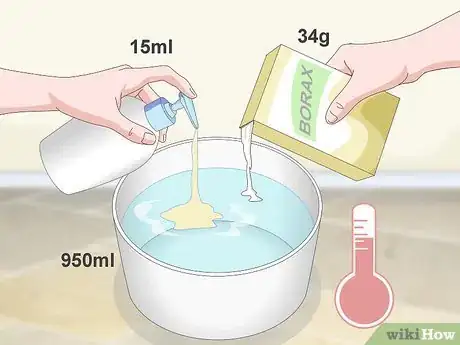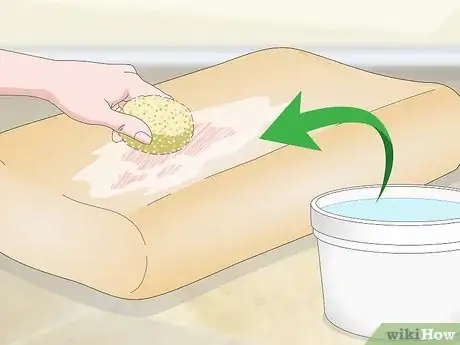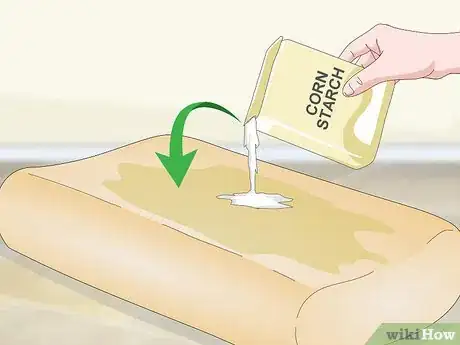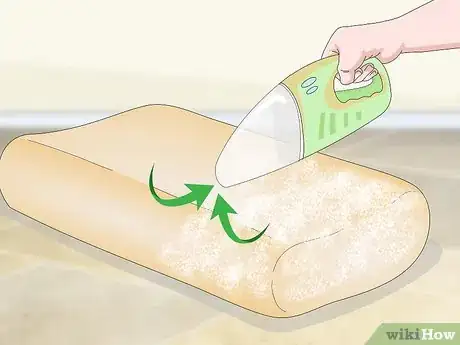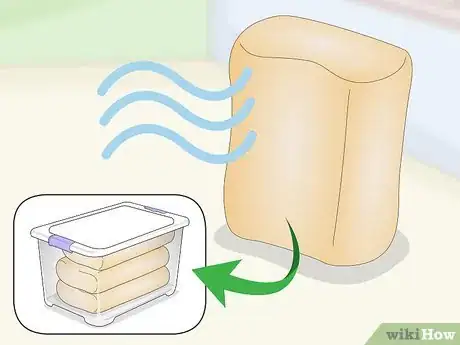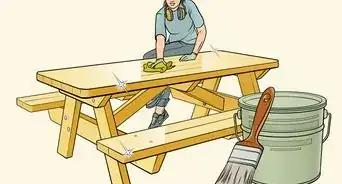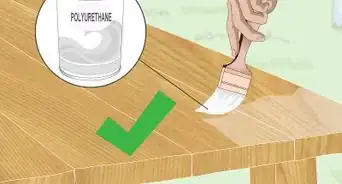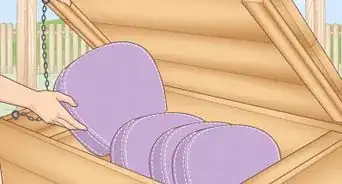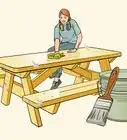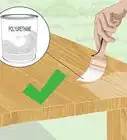This article was co-authored by wikiHow Staff. Our trained team of editors and researchers validate articles for accuracy and comprehensiveness. wikiHow's Content Management Team carefully monitors the work from our editorial staff to ensure that each article is backed by trusted research and meets our high quality standards.
There are 8 references cited in this article, which can be found at the bottom of the page.
This article has been viewed 38,609 times.
Learn more...
Proper storage is an important part of preserving outdoor furniture cushions. Your cushions collect a lot of debris while they’re outside, so they need to be washed with soap and water first. Harsh stains, particularly from mold and mildew, must be treated so they don’t spread. All cushions should be dried before they are stored over the winter. Keep them in a safe spot so you have clean, bright cushions when the weather begins to warm up.
Steps
Preparing the Cushions for Storage
-
1Brush debris off the cushions. If you prefer not to get your hands dirty, use any dry cloth or towel you have available. Give all of your cushions a dry brushing before washing. Your cushions may have accumulated a lot of dirt and dust over the summer that can settle into the fabric as stains.[1]
- A vacuum with an upholstery attachment is very useful for getting dirt out of seams and zippers.
- You may also use a nylon scrub brush to remove stubborn debris. Nylon bristles aren’t stiff enough to damage the cushion fabric.
-
2Take off removable cushion covers and machine wash them. Remove slipcovers and zippered covers to give them a thorough washing. You can easily clean them in a washing machine set for a gentle cycle. Use a regular, non-abrasive liquid laundry detergent.[2]
- Check the cushion’s tag for the manufacturer’s recommended washing instructions.
- If you do not wish to put covers through a washing machine cycle, you can clean them by hand. Separate them from the cushions, then scrub them with the same soap and water mixture you will need for the cushions.
Advertisement -
3Mix liquid dish detergent in warm water to hand-wash the cushions. Fill a bucket with about 1 gallon (3.8 L) of clean water. Mix in 2 fluid ounces (59 mL) of detergent to make some soapy water. You can use any natural or non-abrasive detergent you have on hand to clean any cushions, including those with non-removable covers.[3]
- A non-abrasive detergent should be labeled as “gentle” or not designed to handle tough grease stains.
- If you don’t have a suitable dish detergent, a good liquid laundry detergent should also work.
-
4Use a brush or towel to scrub the cushions. Dip a nylon scrub brush, towel, or sponge into the soapy water. Scrub any stains on the cushions to remove them. You may need to treat the stains multiple times in order to completely eradicate them.[4]
- Avoid using stiff-bristled brushes, since these can damage or puncture cushions and cushion covers.
- You can scrub the cushions outdoors, in a sink, or in a bathtub to avoid a mess.
-
5Rinse soap off the cushions with clean water and a towel. Dampen a clean towel in lukewarm water. Use it to wipe down the cushions, removing any soap and debris. If the towel ever appears dirty, rinse it under running water to wash away the accumulated debris. Keep wiping the cushions until all the suds are gone.[5]
- You can also spray the cushions with a hose, but keep in mind that some cushions cannot be soaked safely.
- If your cushions still do not look clean, try washing them again. If you notice any tough stains, treat them first.
-
6Dry the cushions in an open area out of direct sunlight. Set your cushions and any cushion covers, if they are still wet, on a countertop, on your porch, or in another warm area. Put a towel or newspaper underneath the cushions to collect dripping water. If you can, stand the cushions up so they dry evenly. The cushions must be thoroughly dried before storage so mold doesn’t form on them.[6]
- Drying may take about 30 minutes, depending on the temperature in your area and how wet the cushion is.
- If you can’t stand the cushions upright, flip them over after about 15 minutes to speed up the drying process.
- While you can put your cushions in direct sunlight, this may lead to sun damage and faded colors.
Storing Cushions Properly
-
1Store cushions in plastic bins to seal out moisture. An easy way to store your cushions is by purchasing a storage unit from a general store. Plastic bins are often resealable and effective at keeping water and pests out.[7]
- Plastic bins can be placed in areas that may be a little damp, such as a shed or basement.
- Make sure the storage unit is clean before placing your cushions in it. You can rinse it out with soap and water if it appears dirty.
-
2Use all-purpose fabric bags to preserve natural fabric cushions. Fabric bags are made with natural materials, such as canvas. This allows air to circulate in the bag, preventing moisture from collecting on the cushions. They fit around your cushions, so they aren’t big and bulky like many plastic containers are. You can order fabric bags online and find them at some general retailers.[8]
- Organic fibers, such as linen and cotton, benefit from the air circulation fabric bags provide.
- If a fabric bag gets wet, your cushions will too. Avoid storing them in damp locations.
-
3Wrap cushions in a plastic tarp if you are short on space. Plastic tarps are a makeshift storage option, and keeping moisture out isn’t guaranteed. You can seal cushions better by wrapping them more tightly in the plastic. The wrapped cushions can then be placed wherever you have space, from your garage to your attic. You can find tarps at most home improvement stores.
- Plastic tarps resist water well. However, water may still drip inside improperly-wrapped cushions.
- If the wrapping comes undone, your cushions will be exposed to the air, which can be an issue in a humid environment.
-
4Move cushions to enclosed, dry spots for better protection. Enclosed areas are the best storage spaces. After you have selected a storage method, put your cushions on a shelf in your garage, attic, or a similar spot. Make sure there is no moisture in this spot, since any water can mean you will uncover mold-stained cushions in spring.[9]
- Enclosed areas like sheds offer protection from rain. However, be aware of water leaks as well as moisture in the air.
- If you open nearby doors and windows a lot, humidity and temperature changes can damage the cushions.
-
5Store the cushions under a bench or steps to conserve space. Make sure your bench or steps are solid so water doesn’t drip through them. If your cushions aren’t sealed, rain can be a problem. Wrap your cushions in plastic first to ensure they stay as dry as possible.[10]
- If the bench or steps are out in the open, make sure water doesn’t soak the ground around the cushions.
- These storage spots can leave your cushions vulnerable to pests that chew through fabric, such as bugs and rats.
Treating Stains and Mold
-
1Create a bleach and soap mixture to treat mold. Mold is a serious problem that ruins cushion fabric if it is not removed. You can handle it by mixing 0.5 fluid ounces (15 mL) of liquid dish detergent in a bucket filled with approximately 32 fluid ounces (950 mL) of warm water. Then, mix in 1.2 ounces (34 g) of borax.[11]
- You may be able to use chlorinated laundry bleach if you don’t have borax. Check the manufacturer’s label to see if this is safe.
-
2Blot the cleaning solution onto moldy spots with a sponge. Avoid pouring the solution directly onto the cushion. Dip a clean sponge, nylon scrub brush, or white towel into it. Gently press the solution onto the moldy spots.[12]
- You can also pour the mixture into a spray bottle, then spray a light coating onto the stains.
- If you are unsure about using a borax or bleach solution, test it in an inconspicuous spot on your cushions first.
-
3Let the solution soak for 15 minutes. Leave your cushions out in open air while giving the solution time to soak into the stain. Then, come back and check the stains. If they aren’t removed at this point, you can try cleaning them again.[13]
- Use more of the solution if you are certain you have mold or mildew stains. Otherwise, switch to using absorbent material to draw out the stain.
-
4Rinse the cleaned spots immediately with clean water. Moisten a clean, white cloth or sponge in lukewarm water. Scrub all the treated spots to remove any solution left on the cushions. For extra cleaning power, scrub the spots with a scrub brush dipped in clean water.
- Avoid letting the bleach stay on the cushion, since this can stain or damage fabric.
- You can spray the cushions with a hose to ensure all the bleach is removed.
-
5Spread cornstarch over oily stains to draw them out. Cornstarch, or another absorbent material such as newspaper or baking soda, may help you if the bleach fails. This material works best on oil-based stains, such as body oil, sunscreen, bird droppings, and pizza grease. Sprinkle the material until it covers the stains in an even layer.[14]
- You can apply cornstarch immediately after washing a cushion with soap and water. However, using bleach first can help with tougher stains.
-
6Vacuum the cornstarch off after 15 minutes. Use a vacuum with an upholstery attachment to remove any absorbent material. You can also brush it off or scrape it off with a flat, solid object, such as an old credit card or straight edge. The stain should no longer be noticeable on your cushion.[15]
- If stains are still present, continue washing your cushions. Repeated treatments with either cornstarch or bleach may help.
-
7Dry wet cushions completely before storing them. Stored cushions need to be dry in order to prevent mold and mildew growth. The best way to dry the cushions is to stand them upright in a warm, dry spot out of direct sunlight. If you choose to lay the cushions flat, remember to turn them over after about 15 minutes so all sides dry evenly.[16]
- To prevent mold growth, move the cushions indoors when they are not in use. Dry them out immediately if they are left in the rain.
- If you need to dry cushions in a hurry, use a towel to blot out excess moisture, then leave the cushions in a heated area. You can heat them carefully with a blowdryer on a low setting.
Warnings
- Bleach is a harsh chemical. Use it in a well-ventilated area and test it in an inconspicuous spot on your cushions first.⧼thumbs_response⧽
Things You’ll Need
Washing Cushions for Storage
- Warm water
- Towel
- Bucket
- Dish or laundry detergent
Choosing a Storage Spot
- Plastic bin
- Fabric bag
- Plastic wrap
- Dry spot
Preserving Your Cushions
- Water
- Sponge
- Borax
- Cornstarch
- Towel
References
- ↑ https://dolly.com/blog/outdoor-furniture-cleaning-how-to-clean-your-patio-furniture/
- ↑ https://www.bobvila.com/articles/how-to-clean-patio-cushions/
- ↑ https://www.bobvila.com/articles/how-to-clean-patio-cushions/
- ↑ https://www.todayshomeowner.com/how-to-clean-outdoor-patio-and-deck-furniture/
- ↑ https://dolly.com/blog/outdoor-furniture-cleaning-how-to-clean-your-patio-furniture/
- ↑ https://www.washingtonpost.com/lifestyle/home/how-to-clean-outdoor-furniture/2013/05/07/ac9494d8-b35a-11e2-9a98-4be1688d7d84_story.html?noredirect=on&utm_term=.716dee993bcd
- ↑ https://www.architecturaldigest.com/story/linen-storage-ideas
- ↑ https://www.architecturaldigest.com/story/linen-storage-ideas
- ↑ https://www.goodhousekeeping.com/home/organizing/tips/a26179/basement-attic-storage/
- ↑ https://www.goodhousekeeping.com/home/organizing/tips/a26179/basement-attic-storage/
- ↑ https://www.homeright.com/projects/clean-patio-cushions-cards-drew/
- ↑ https://www.bobvila.com/articles/how-to-clean-patio-cushions/
- ↑ https://www.todayshomeowner.com/how-to-clean-outdoor-patio-and-deck-furniture/
- ↑ https://www.simplemost.com/the-best-way-to-clean-your-outdoor-patio-cushions/
- ↑ https://www.simplemost.com/the-best-way-to-clean-your-outdoor-patio-cushions/
- ↑ https://www.washingtonpost.com/lifestyle/home/how-to-clean-outdoor-furniture/2013/05/07/ac9494d8-b35a-11e2-9a98-4be1688d7d84_story.html?noredirect=on&utm_term=.716dee993bcd
